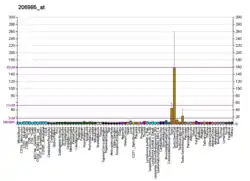HSD17B3
17β-Hydroxysteroid dehydrogenase 3 (17β-HSD3) is an enzyme that in humans is encoded by the HSD17B3 gene and is involved in androgen steroidogenesis.[5][6][7]
| HSD17B3 | |||||||||||||||||||||||||||||||||||||||||||||||||||
|---|---|---|---|---|---|---|---|---|---|---|---|---|---|---|---|---|---|---|---|---|---|---|---|---|---|---|---|---|---|---|---|---|---|---|---|---|---|---|---|---|---|---|---|---|---|---|---|---|---|---|---|
| Identifiers | |||||||||||||||||||||||||||||||||||||||||||||||||||
| Aliases | HSD17B3, EDH17B3, SDR12C2, hydroxysteroid (17-beta) dehydrogenase 3, hydroxysteroid 17-beta dehydrogenase 3 | ||||||||||||||||||||||||||||||||||||||||||||||||||
| External IDs | OMIM: 605573 MGI: 107177 HomoloGene: 20089 GeneCards: HSD17B3 | ||||||||||||||||||||||||||||||||||||||||||||||||||
| |||||||||||||||||||||||||||||||||||||||||||||||||||
| |||||||||||||||||||||||||||||||||||||||||||||||||||
| |||||||||||||||||||||||||||||||||||||||||||||||||||
| |||||||||||||||||||||||||||||||||||||||||||||||||||
| |||||||||||||||||||||||||||||||||||||||||||||||||||
| Wikidata | |||||||||||||||||||||||||||||||||||||||||||||||||||
| |||||||||||||||||||||||||||||||||||||||||||||||||||
Function
This isoform of 17β-HSD is expressed predominantly in the testis and catalyzes the conversion of androstenedione to testosterone. It preferentially uses NADP as cofactor. Deficiency can result in impaired virilization of genetically male infants, formerly termed male pseudohermaphroditism.[8][7]
See also
References
- GRCh38: Ensembl release 89: ENSG00000130948 - Ensembl, May 2017
- GRCm38: Ensembl release 89: ENSMUSG00000033122 - Ensembl, May 2017
- "Human PubMed Reference:". National Center for Biotechnology Information, U.S. National Library of Medicine.
- "Mouse PubMed Reference:". National Center for Biotechnology Information, U.S. National Library of Medicine.
- Geissler WM, Davis DL, Wu L, Bradshaw KD, Patel S, Mendonca BB, Elliston KO, Wilson JD, Russell DW, Andersson S (May 1994). "Male pseudohermaphroditism caused by mutations of testicular 17 beta-hydroxysteroid dehydrogenase 3". Nature Genetics. 7 (1): 34–9. doi:10.1038/ng0594-34. PMID 8075637. S2CID 23241.
- Persson B, Kallberg Y, Bray JE, Bruford E, Dellaporta SL, Favia AD, Duarte RG, Jörnvall H, Kavanagh KL, Kedishvili N, Kisiela M, Maser E, Mindnich R, Orchard S, Penning TM, Thornton JM, Adamski J, Oppermann U (March 2009). "The SDR (short-chain dehydrogenase/reductase and related enzymes) nomenclature initiative". Chemico-Biological Interactions. 178 (1–3): 94–8. doi:10.1016/j.cbi.2008.10.040. PMC 2896744. PMID 19027726.
- "Entrez Gene: HSD17B3 hydroxysteroid (17-beta) dehydrogenase 3".
- "Testosterone 17-beta-dehydrogenase deficiency - Conditions - GTR - NCBI". www.ncbi.nlm.nih.gov. Retrieved 2017-03-17.
Further reading
- Ademola Akesode F, Meyer WJ, Migeon CJ (December 1977). "Male pseudohermaphroditism with gynaecomastia due to testicular 17-ketosteroid reductase deficiency". Clinical Endocrinology. 7 (6): 443–52. doi:10.1111/j.1365-2265.1977.tb01336.x. PMID 598011. S2CID 72297230.
- Eckstein B, Cohen S, Farkas A, Rösler A (February 1989). "The nature of the defect in familial male pseudohermaphroditism in Arabs of Gaza". The Journal of Clinical Endocrinology and Metabolism. 68 (2): 477–85. doi:10.1210/jcem-68-2-477. PMID 2918056.
- Rösler A, Kohn G (July 1983). "Male pseudohermaphroditism due to 17 beta-hydroxysteroid dehydrogenase deficiency: studies on the natural history of the defect and effect of androgens on gender role". Journal of Steroid Biochemistry. 19 (1B): 663–74. doi:10.1016/0022-4731(83)90233-9. PMID 6310248.
- Andersson S, Geissler WM, Wu L, Davis DL, Grumbach MM, New MI, Schwarz HP, Blethen SL, Mendonca BB, Bloise W, Witchel SF, Cutler GB, Griffin JE, Wilson JD, Russel DW (January 1996). "Molecular genetics and pathophysiology of 17 beta-hydroxysteroid dehydrogenase 3 deficiency". The Journal of Clinical Endocrinology and Metabolism. 81 (1): 130–6. doi:10.1210/jcem.81.1.8550739. PMID 8550739.
- Rösler A, Silverstein S, Abeliovich D (May 1996). "A (R80Q) mutation in 17 beta-hydroxysteroid dehydrogenase type 3 gene among Arabs of Israel is associated with pseudohermaphroditism in males and normal asymptomatic females". The Journal of Clinical Endocrinology and Metabolism. 81 (5): 1827–31. doi:10.1210/jcem.81.5.8626842. PMID 8626842. S2CID 46093440.
- Can S, Zhu YS, Cai LQ, Ling Q, Katz MD, Akgun S, Shackleton CH, Imperato-McGinley J (February 1998). "The identification of 5 alpha-reductase-2 and 17 beta-hydroxysteroid dehydrogenase-3 gene defects in male pseudohermaphrodites from a Turkish kindred". The Journal of Clinical Endocrinology and Metabolism. 83 (2): 560–9. doi:10.1210/jcem.83.2.4535. PMID 9467575.
- Moghrabi N, Hughes IA, Dunaif A, Andersson S (August 1998). "Deleterious missense mutations and silent polymorphism in the human 17beta-hydroxysteroid dehydrogenase 3 gene (HSD17B3)". The Journal of Clinical Endocrinology and Metabolism. 83 (8): 2855–60. doi:10.1210/jcem.83.8.5052. PMID 9709959.
- Bilbao JR, Loridan L, Audí L, Gonzalo E, Castaño L (September 1998). "A novel missense (R80W) mutation in 17-beta-hydroxysteroid dehydrogenase type 3 gene associated with male pseudohermaphroditism". European Journal of Endocrinology. 139 (3): 330–3. doi:10.1530/eje.0.1390330. PMID 9758445. S2CID 26522874.
- Lindqvist A, Hughes IA, Andersson S (February 2001). "Substitution mutation C268Y causes 17 beta-hydroxysteroid dehydrogenase 3 deficiency". The Journal of Clinical Endocrinology and Metabolism. 86 (2): 921–3. doi:10.1210/jcem.86.2.7172. PMID 11158067.
- Lee YS, Kirk JM, Stanhope RG, Johnston DI, Harland S, Auchus RJ, Andersson S, Hughes IA (July 2007). "Phenotypic variability in 17beta-hydroxysteroid dehydrogenase-3 deficiency and diagnostic pitfalls". Clinical Endocrinology. 67 (1): 20–8. doi:10.1111/j.1365-2265.2007.02829.x. PMID 17466011. S2CID 8349020.
This article is issued from Wikipedia. The text is licensed under Creative Commons - Attribution - Sharealike. Additional terms may apply for the media files.




